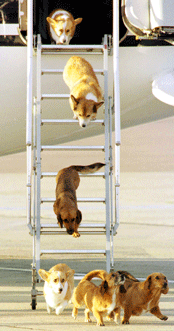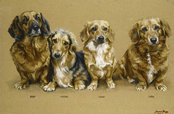The truth about the Queen’s Corgis
'She would laugh and say, "They are always fighting in front of people, which is very embarrassing",' recalled the wife of an Indian diplomat. 'It is amusing to see when dogs fail to obey a royal command,' said a former courtier.

The corgis have been known to take a nip at footmen and sentries, and also one of the Queen's ladies-in-waiting, Fortune FitzRoy, the Duchess of Grafton. 'They're heelers,' the Queen once explained. 'They're cattle dogs so they bite,' adding with a sly smile, 'they chase people.'
Simon Walker, the former head of communications for British Airways, was surprised to see the corgis when he arrived for an interview with the Queen for the job of press secretary in June 2000. She asked if he minded standing, since she had been sitting for a portrait for three hours. As they talked, one of the dogs insistently tugged at Walker's trouser leg, which made standing still a challenge. The Queen didn't try to stop the dog, nor did she seem to take any notice at all, and Walker decided that his ability to endure the distraction was meant to test his unflappability.
Queen Elizabeth was taught to suppress her emotions as a child, but she could lavish her furry companions with affection. Her former lady-in-waiting, Lady Pamela Hicks, wrote her a note after one of her corgis had died, and the Queen replied with a six-page letter. 'A dog isn't important,' Hicks figured, 'so she can express the really deep feelings she can't get out otherwise.'
Several years ago, during a shooting weekend at Sandringham, the Queen learned about the death of Emma, the last of her mother's corgis. Visibly saddened, she went around the room before dinner and gave the news to each of the guests as Prince Philip tried to console her.

In her job, the Queen is required to keep a great deal of confidential information to herself, a feat she accomplishes by compartmentalising. 'If you have had constraints about not talking, you need some outlet,' said Margaret Rhodes, her cousin. 'While she and her husband talk freely, she does let loose with her dogs.'
The Queen's long solitary walks with the corgis help her release tension when she feels frustration or anguish, sometimes pulling up a deeply rooted weed called a Stinking Willie while out in the fields near Balmoral, her estate in Scotland.
'The reason the Queen likes her dogs so much is that she can relax with them,' noted her long-time senior adviser, the late Sir Martin Charteris. After a footman has given them their first walk of the day, they surge into the Queen's bedroom, and then cluster around her table at breakfast, when she tosses them scraps of toast.
In the afternoon she takes them out in Buckingham Palace gardens before serving them their dinner. A chef prepares the ingredients that include dog food as well as cooked rabbit, chicken, steak, or pheasant, which she ladles into individual bowls with a silver spoon and fork, mixing in gravy and crumbled biscuits.

Rarely satisfied by their bespoke meals, they eagerly gobble the bits of scone she feeds them later when she has her tea. Everyone in the Queen's family and household understands the importance of the Queen's attachment to her pets.
Martin Charteris, who sculpted cast-iron firebacks as a hobby, was unable to finish the one he was creating for the Queen in the last year of his life, so a young sculptor at Eton College completed the job.
The fireback, which sits in St George's Hall at Windsor Castle, has all the usual royal emblems, as well as a fanciful touch: a trio of corgis in one corner.
'I know if Martin had lived, one of the corgis would have lifted its leg,' said his widow, Mary Gay Charteris.
Perfect breeding...

The corgi's origin is difficult to trace. An 11th-century manuscript mentions a Welsh cattle dog, but there is no evidence to prove whether this is the corgi or an ancestor.
Welsh folklore says the corgi is the preferred mount of fairy warriors. There is also a legend that corgis were a gift from the woodland fairies, and that the breed's markings were left on its coat by fairy harnesses and saddles. Corgis often have a white stripe that runs from the nose, through the eyes and up into the forehead, this marking is referred to as their blaze.
The first recorded date for corgis appearing in the show ring in Wales is 1925. These first show corgis were straight off the farm and gained only moderate attention. Subsequent breeding efforts to improve on the dog's natural good looks were rewarded with increased popularity.
For years the two breeds, the Cardigan Welsh corgi and the Pembrokeshire Welsh corgi, were shown as two varieties of a single breed. Since the two corgi breeds were developed in the Welsh hillcountry, in areas only a few miles apart, there is evidence of crossbreeding between the two, which accounts for the similarities.
Susan, the Queen's first corgi, given to her by her father when she was 18, was a Pembrokeshire. In subsequent years, the Queen bred not only from Susan, but from some of her other female corgis, using outside stud dogs.
At present, the Queen owns three Corgis: Monty, Willow and Holly. All of the dogs travel with her to her various residences and she likes to look after them herself as much as possible, given her busy schedule.
Dorgis

Some of the Queen's Pembroke Welsh corgis were mated with dachsunds (notably Pipkin, who belonged to Princess Margaret) to create 'dorgis', now recognised as a hybrid with some designer cache. They look more like the corgi, but the dorgi tends to take its personality from the dachshund, making them keen to please their owners, with a tendency to stick close at heel.
Like many devoted dog owners, the Queen has commissioned several portraits of her pets. Jemma Phipps has painted the springer spaniels that live at Sandringham and four of the dorgis (right). 'They were extremely wellbehaved,' she says of the canine sitters. 'And they stood beautifully.'
Jemma is available for commissions:
07799-588342, www.jemmaphipps.com


